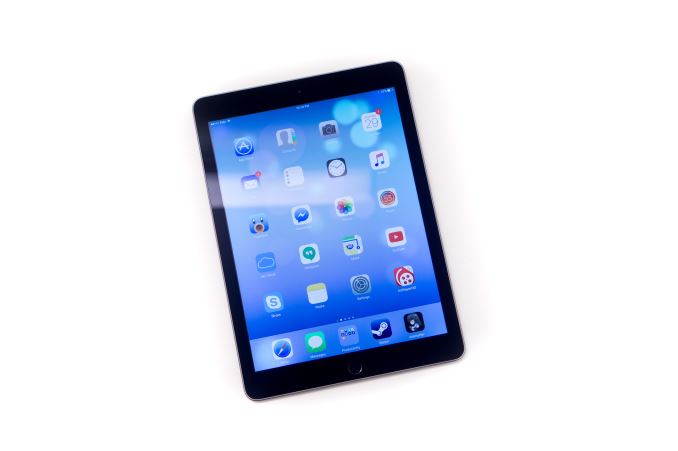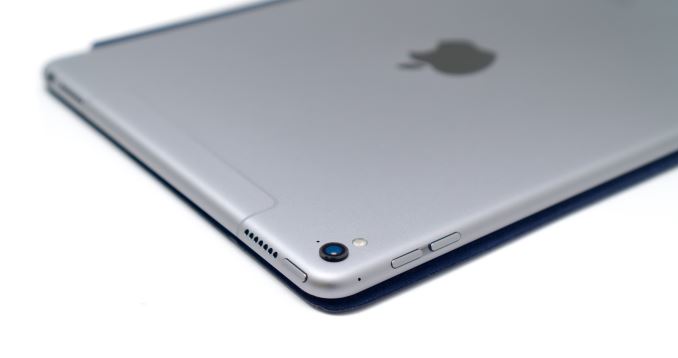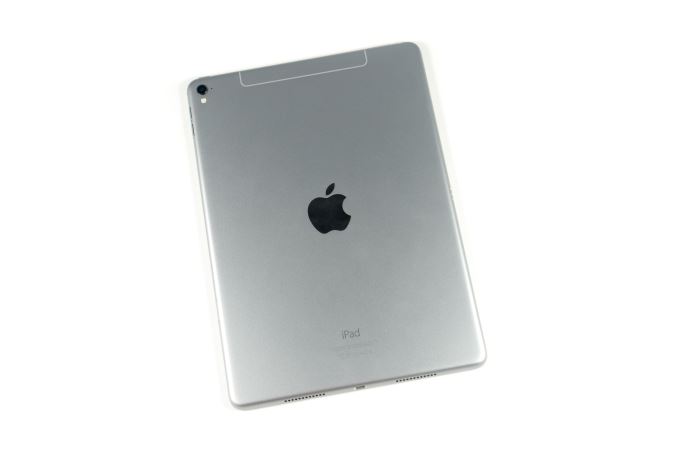The 9.7" iPad Pro Review
by Brandon Chester on June 1, 2016 9:00 AM EST
In late 2015 Apple launched a tablet that they called the iPad Pro. It had been rumored for quite some time, and it had a number of features that differentiated it from other iPads. The most notable was its 12.9" display, which has a width equal to the height of Apple's 9.7" iPads, allowing it to use two essentially full sized iPad applications at the same time in a split screen view. In addition to its massive display, the iPad Pro came with two accessories that had not existed for any prior iPad. It seemed that in Apple's eyes the Apple Pencil and the Smart Keyboard really defined what made the iPad Pro worthy of the "Pro" name.
Meanwhile, the launch of the iPad Pro came and went, and there was no news of a successor to Apple's iPad Air 2, which had just turned one year old. I thought that this move may have had to do with Apple not facing much competition in the tablet market. On the other hand, with iPad sales down it wouldn't generate much excitement to keep selling the same tablet for a second year.
After the launch of the iPad Pro the rumor mill continued to churn out new info, and there were whispers of a so called "iPad Air 3" coming in early 2016. Later, the story became that Apple was actually planning another iPad Pro to take the place of the iPad Air 2 as Apple's flagship 9.7" iPad. In the end it turned out that Apple did exactly that, and along with bringing the specs of the larger iPad Pro to a smaller size, the smaller iPad Pro comes with some surprises of its own. Below you can view the current state of the iPad line now that Apple has two devices called the iPad Pro.
| Apple iPad Family | |||
|
|
Apple iPad Air 2 | Apple iPad Pro 9.7" | Apple iPad Pro 12.9" |
| SoC | Apple A8X 3 x Apple Typhoon @ 1.5GHz |
Apple A9X 2 x Apple Twister @ ~2.2GHz |
Apple A9X 2 x Apple Twister @ ~2.2GHz |
| GPU | PowerVR 8 Cluster Series6XT | PowerVR 12 Cluster Series7XT | |
| RAM | 2GB LPDDR3 | 2GB LPDDR4 | 4GB LPDDR4 |
| NAND | 16/64/128 GB | WiFi: 32 / 128 / 256 GB | |
| WiFi + Cellular: 32 / 128 / 256 GB |
WiFi + Cellular: 128 / 256 GB |
||
| Display | 9.7" 2048x1536 IPS LCD | 12.9" 2732x2048 IPS LCD | |
| Gamut | sRGB | DCI-P3 | sRGB |
| Size and Mass | 240 x 169.5 x 6.1mm 437g WiFi, 444g LTE |
305.7 x 220.6 x 6.9 mm 713g WiFi, 723g LTE |
|
| Camera | 8MP Rear-facing f/2.4, 1.1 micron |
12MP Rear-facing f/2.2, 1.22 micron |
8MP Rear-facing f/2.4, 1.1 micron |
| 1.2MP Front-facing f/2.2 | 5MP Front-facing f/2.2 | 1.2MP Front-facing f/2.2 | |
| Battery | 27.3 Wh | 27.5 Wh | 38.5 Wh |
| Launch OS | iOS 8 | iOS 9 | |
| Cellular | Category 4 LTE + GPS/GNSS in Cellular SKU | ||
| Other Connectivity | 2x2 802.11a/b/g/n/ac + BT 4.2, Apple Lightning, Smart Connector on iPad Pro | ||
| SIM | Optional NanoSIM | ||
| Current Price |
16GB: $399 |
32 GB: $599 128 GB: $749 256 GB: $899 |
32 GB: $799 128 GB: $949 256 GB: $1079 (LTE) |
The 9.7” iPad Pro has the same core industrial design that Apple’s iPads have used since the launch of the iPad Air. The back is almost entirely flat, curving up quickly near the edges and meeting the cover glass with a shiny chamfered edge. Like the 12.9” model, the 9.7” iPad Pro changes things up by moving to a four-speaker audio setup, which requires holes drilled on both the top and bottom of the chassis. Interestingly, the 9.7” iPad Pro uses asymmetrical speaker grilles, with the bottom two being larger than those of the 12.9” model, and the top being smaller. This is likely due to the more constrained space inside the chassis. As for the speakers themselves, the audio quality did seem to be a step down from the larger iPad Pro, but it’s still miles ahead of anything else that I’ve seen on a tablet of this size and a significant improvement from the iPad Air 2.
The 9.7” iPad also comes with some changes of its own. The camera now has a hump, which will undoubtedly upset those who focus heavily on the uniformity of the design. There was no good way to improve upon the iPad Air 2’s camera within a 6.1mm chassis without putting a hump, and as we’ll see later, the camera in this iPad Pro is a huge improvement over Apple’s other iPads. While the hump is there, with such a large chassis the angle it makes with a flat surface is so small that the tablet doesn’t rock back and forth when using it on a table, which is extremely important to ensure the usability of the Apple Pencil.
Apple has also changed up the antenna design. Going back to the first iPads, the cellular models have sported a plastic RF window at the top of the chassis to allow for RF propagation. With the 9.7” iPad Pro, Apple adopts a similar antenna design to that of the iPhone 6 and 6s, where the top now has a metal segment for the antenna with insulating plastic lines surrounding it.
I think this is a significant upgrade to the design of the cellular model for a couple of reasons. Aesthetically it simply looks better, as the plastic inserts weren’t color matched and so they stood out from the rest of the aluminum back cover. They also weren’t always aligned perfectly, and so at the edge between the plastic and the aluminum you could feel a noticeable seam due to the plastic being either at a higher or lower level than the chassis. The new antenna design eliminates both of these issues, and brings the 9.7” iPad Pro as close as it can get to an unbroken aluminum unibody when also having to support cellular networking.
Beyond the changes with the camera, speakers, and antenna on the cellular model, the 9.7” iPad Pro has the same design as the iPad Air 2. They share the same mass and dimensions, and as I mentioned before the core ID is the same. Whether or not Apple could improve upon the design further is up for debate, but they don’t really have any true competition in this space and so they’ve been able to maintain their design lead by making iterative improvements on the original iPad Air design. That design still works very well, and so I don’t see much reason to change things up significantly just for the sake of saying you have a new design.












144 Comments
View All Comments
digiguy - Friday, June 3, 2016 - link
What do you know? even core I7 has been made fanless in a 12 inch tablet with a new cooling solution, so I don't see why core M could not work well in 10 inches. Battery life will depend on the battery size, in the onda it's smaller than in ipad air 2 for instance, and it lasts around 4 hours, with a bigger one it could last more, but is definitely much more than the 1 hour you speculate about...erple2 - Sunday, June 5, 2016 - link
But then that's the point, isn't it? Throwing a honestly poorly designed 10" tablet as proof that you can get a good tavlet with Core M is not helping your argument. How good is the display? How are the touch apps? How well does the pen work? How heavy is it? How hot does it run? How long does it run on a charge? What about everything else that is tested? Honestly, there has to be a reason why the big players hasn't integrated a more powerful CPU into a small tablet.As a staunchly anti Apple person, I gave to co cede that Apple really does have the best tablet this generation. While the Pixel C comes close, the Pen is very well implemented. Surfaces are fine, but I find that when I want to do real work, I turn to my much more powerful laptop to do that.
melgross - Wednesday, June 1, 2016 - link
Neither Surface Pro display can match the display for this product. First of all those products were reviewed before this one came out, and secondly, they are both sRGB displays, with their resultant smaller color gamut.Also, the iPad Pro, either model beats the least expensive Surface Pro in performance, and that model costs as much, or more than the competing iPad.
I understand that your Microsoft products are second best in a number of ways. Get used to it.
jlabelle2 - Thursday, June 2, 2016 - link
Having a wider color gamut than sRGB is not universally an advantage. Without going into this discussion on how many (little) images are benefiting from that, even in a proper color managed workflow (and iOS seems to be quite good here), sharing and distributing images with wider color space than sRGB is often (most of the time) counterproductive if others 1/ do not have wide gamut screen (the majority), 2/ do not have applications / browser reading the embedded color space (the majority). As such, the interest is honestly quite limited. It does not hurt at all the iPad, on the contrary, but in real life this is not what will make such display stands above other sRGB gamut wide screens.And regarding the Surfaces and DisplayMate, read in details and you will see they are also praised equally :
"The Surface Pro 4 also has the most accurate on-screen colors of any Tablet display that we have ever measured"
"However, Microsoft has also taken an important initial step, with the Surface 3 providing its best Color Accuracy in typical indoor 300 lux ambient"
My point is that many tablets have just excellent screens and that the iPad Pro does not seem to stand in a class of its own at all. But what makes Surfaces screens a real treat for people that value color accuracy is being able to calibrate the screen. That is making all the difference.
Because LCD screen colors evolve unfortunately with time. It would be interesting that Brandon would test and iPad Air 2, today, used since the beginning and how it differs of the original out of the box measurement.
As such, if we are taking only this criteria, for designer or photo / video editor that value utmostly color accuracy, the non calibrating iPad display is a drawback. I mentioned this because making some photo editing on the wedding I shoot, I can clearly see that the iPad Air 2 I have is no match with the Surface Pro 3 I also have, once calibrated.
Meteor2 - Thursday, June 2, 2016 - link
Cor, you're angry.grayson_carr - Thursday, June 2, 2016 - link
You can compare the displays at the link below. Basically, the calibrations are on par out of the box, with the iPad having a slightly better calibrated white point. The iPad has MUCH higher max brightness and a higher color gamut. The Surface Pro 4 has slightly better contrast and like you said, the ability to do your own calibration. Out of the box I would say the iPad Pro has the slight edge with the higher brightness, higher color gamut, and true tone feature. But the Surface Pro 4 display might be better for professionals down the road with the ability to recalibrate it.http://www.anandtech.com/bench/product/1697?vs=157...
nikon133 - Thursday, June 2, 2016 - link
Performance... in what scenarios? Only if there are pro apps to take advantage of that power, does performance have any meaning. Right now, iPad Pro's "power" is only good for rubbing it into others' faces over a cup of coffee. Once these babies are put to use, iPP turns out just faster iPad, but far cry from Pro device. In real life, it is just an iPad that will turn iBook pages faster, do smoother fly-overs in Apple Maps. Have Apple decided to call it iPad Air 3, no-one would know the difference.I'm finding it ironical that, for ecosystem (and fans) insisting on quality and quantity of casual apps in library, suddenly lack of apps in Pro segment is being ignored or played down. One can't do much on it, but look, oooh, it is so fast.
iPad Pro can be twice as fast as i7 Surface... but without tools from Adobe, Corel, Audodesk... even full-blown Office suite... how is it better Pro tablet than any x86 device?
Re pricing. I cannot compare 32GB iPP with 128GB SP. Much as prices go here in NZ - might differ where you are - 128GB 9.7" iPP is NZ$1,329.00, plus NZ$189 for pen. That makes NZ$1,518, compared to $1,439 for 128GB mCore SP4, which comes with pen. Even if we ignore that these are prices from Apple's and MS's web stores and that SP can be found even cheaper in shops, while iPP basically can't... even if we stick to these prices... you are saying that more expensive device with smaller screen, crippled multitasking, no real library of pro software, no easy (or any, in some cases) way to dock it, connect it to multiple desktop screens, wired network, USB devices... is somehow better device just because it cranked out better score in some synthetic benchmarks..?
OK...
Lochheart - Friday, June 3, 2016 - link
Yes, the Surface can run Adobe, Corel, Autodesk... etc...Do you think anyone will buy a Surface when it need to work on Adobe tools ? It will never happen.
Who work on a 12" screen ? My 15" Laptop is already to small... So yes, a Surface can run lot of stuff... but compare to what we have on PC side, it's just a outdated config overhype.
jlabelle2 - Tuesday, June 14, 2016 - link
"Do you think anyone will buy a Surface when it need to work on Adobe tools ? It will never happen."I do. This is why I replaced my iPad (my wife is still using her iPad Air 2 for casual stuff) with a SP3 and gave my desktop to my kids. I am using the SP3 as a tablet in the bed, train, airplane for media consumption and tablet things, I am attaching the keyboard when I want to type things, but I can also develop my RAW files in the train with Capture One Pro (alternative from Adobe Lightroom) or in the bed in tablet mode. And 12" is plenty enough to work on pictures as the screen is high resolution and you can easily pinch to zoom.
Or I can simply dock it and use it with a calibrated 27" monitor / keyboard and mouse. That is THE point of using a Surface. Doing more than an iPad.
"but compare to what we have on PC side"
It IS a PC. Also. It replaces basically the need for a PC for 98% of the people.
mrochester - Wednesday, June 1, 2016 - link
I see you post in a similar vain here as you do on the Verge forums!